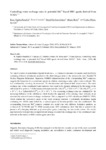Controlling Water Exchange Rates in Potential Mn²⁺-Based MRI Agents Derived From NO2A²⁻

Use this link to cite
http://hdl.handle.net/2183/30062Collections
- Investigación (FCIE) [1227]
Metadata
Show full item recordTitle
Controlling Water Exchange Rates in Potential Mn²⁺-Based MRI Agents Derived From NO2A²⁻Author(s)
Date
2019-02-22Citation
R. Pujales-Paradela, F. Carniato, D. Esteban-Gómez, M. Botta and C. Platas-Iglesias, Controlling water exchange rates in potential Mn2+-based MRI agents derived from NO2A2−, Dalt. Trans., 2019, 48, 3962–3972. DOI: 10.1039/C9DT00211A
Abstract
[Abstract] We report a series of pentadentate ligands based on a 1,4,7-triazacyclononane-1,4-diacetic acid (H2NO2A) containing different substituents attached to the third nitrogen atom of the macrocyclic unit. Detailed 1H Nuclear Magnetic Relaxation Dispersion (NMRD) characterisation of the corresponding Mn2+ complexes suggests the formation of six-coordinate species in solution containing an inner-sphere water molecule. This was confirmed by recording the transverse 17O relaxation time and chemical shift measurements. The water exchange rate of the coordinated water molecule was found to be strongly influenced by the nature of the substituent R at position 7 of the triazacyclononane unit (R = Me, k298ex = 62.6 × 107 s−1; R = Bz, k298ex = 4.4 × 107 s−1; R = 1-phenylethyl, k298ex = 2.6 × 107 s−1). The decreasing exchange rates are explained by the increasing bulkiness of the substituent, which hinders the approach of the entering water molecule in an associatively activated water exchange mechanism. This is supported by DFT calculations (M062X/TZVP), which confirm the associative nature of the water exchange reaction. A potentially decadentate ligand containing two NO2A units linked by a xylenyl spacer in the meta position was also synthesised. The corresponding binuclear Mn2+ complex contains two metal ions with different hydration numbers, as evidenced by 1H NMRD and 17O NMR measurements. DFT calculations show that this is related to the presence of a bridging bidentate μ–η1-carboxylate group connecting the two metal centers. The results reported in this work provide a straightforward strategy to control the exchange rate of the coordinated water molecule in this family of MRI contrast agent candidates.
Editor version
ISSN
1477-9234





